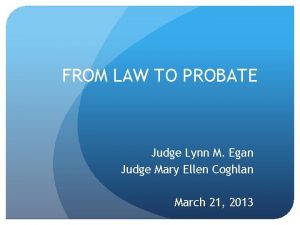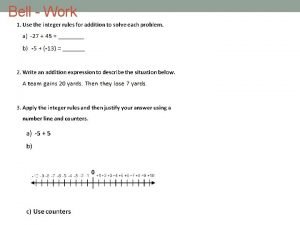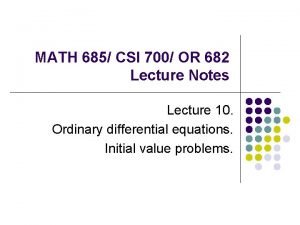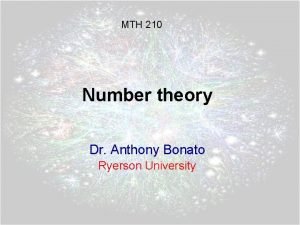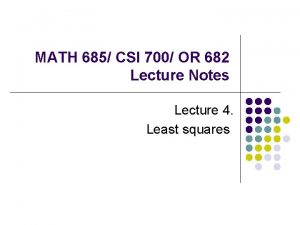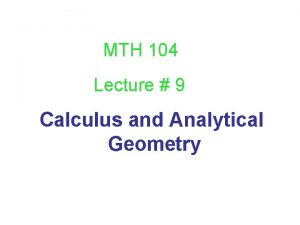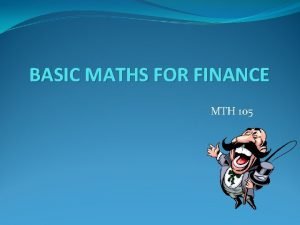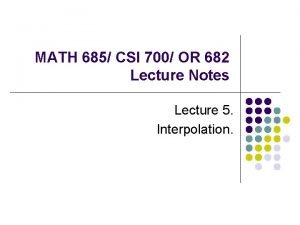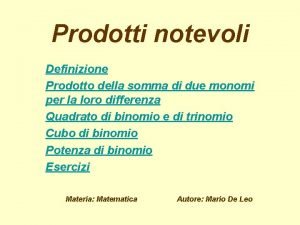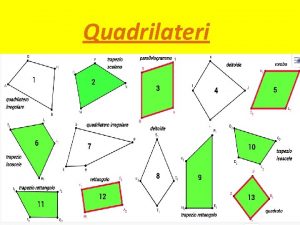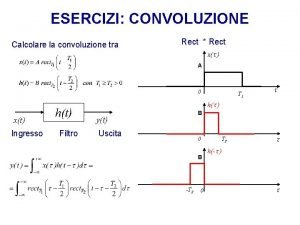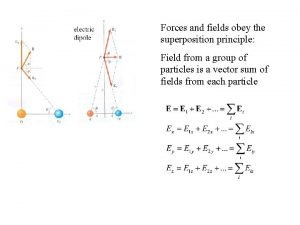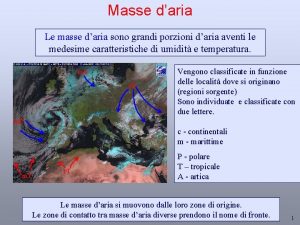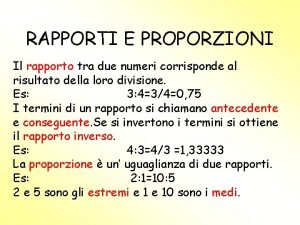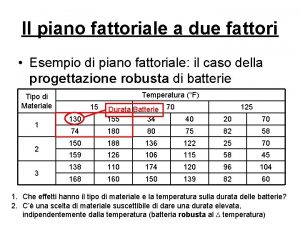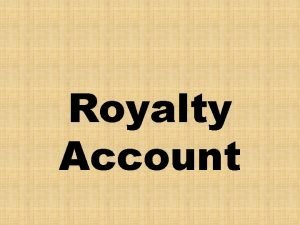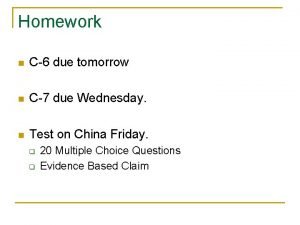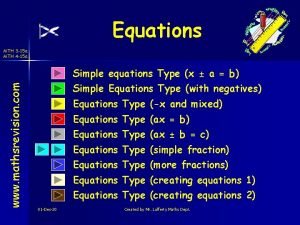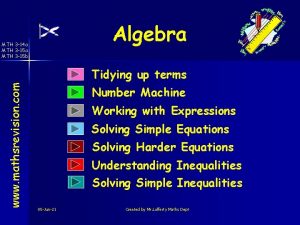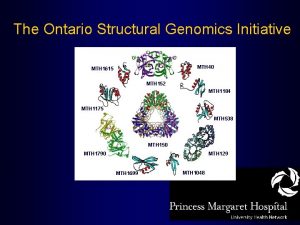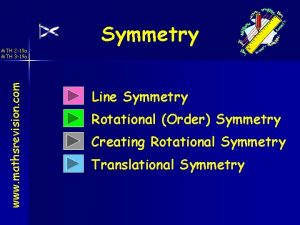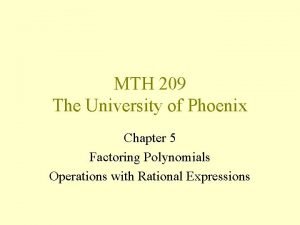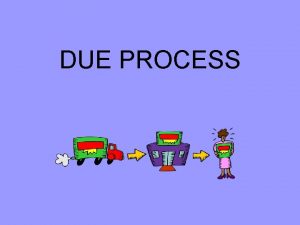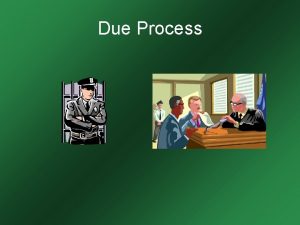MTH 209 Week 3 Due for this week








































































































- Slides: 104

MTH 209 Week 3

Due for this week… § § § Homework 3 (on My. Math. Lab – via the Materials Link) Monday night at 6 pm. Read Chapter 8. 4, 10. 4, 11. 1, 11. 5, 12. 1 -3, 14. 1 -3 Do the My. Math. Lab Self-Check for week 2. Learning team planning for week 5. Discuss your final week topic for your team presentations… Copyright © 2009 Pearson Education, Inc. Publishing as Pearson Addison-Wesley Slide 2

6. 6 Solving Equations by Factoring I (Quadratics) The Zero-Product Property Solving Quadratic Equations Applications Copyright © 2009 Pearson Education, Inc. Publishing as Pearson Addison-Wesley

To solve equations we often use the zero-product property, which states that if the product of two numbers is 0, then at least one of the numbers must be 0.

EXAMPLE Applying the zero-product property Solve each equation. a. b. Solution a. b. Copyright © 2009 Pearson Education, Inc. Publishing as Pearson Addison-Wesley Slide 5

Any quadratic polynomial in the variable x can be written as ax 2 + bx + c with a ≠ 0. Any quadratic equation in the variable x can be written as ax 2 + bx + c = 0, with a ≠ 0. This form of quadratic equation is called the standard form of a quadratic equation. Copyright © 2009 Pearson Education, Inc. Publishing as Pearson Addison-Wesley Slide 6

Slide 7

EXAMPLE Solving equations by factoring Solve each quadratic equation. Check your answers. a. 36 + x 2 = – 12 x b. x 2 − 49 = 0 Solution a. 36 + x 2 = – 12 x x 2 + 12 x + 36 = 0 (x + 6) = 0 x=− 6 To check this value, substitute − 6 for x in the given equation. 36 + (− 6)2 = – 12(− 6) 72 = 72 The only solution is − 6. Copyright © 2009 Pearson Education, Inc. Publishing as Pearson Addison-Wesley Slide 8

EXAMPLE continued Solve each quadratic equation. Check your answers. b. x 2 − 49 = 0 Solution b. x 2 − 49 = 0 (x + 7)(x − 7) = 0 x+7=0 x− 7=0 x = − 7 x=7 To check these values, substitute 7 and − 7 for x in the given equation. 72 − 49 = 0 0=0 (− 7)2 − 49 = 0 0=0 The solutions are − 7 and 7. Copyright © 2009 Pearson Education, Inc. Publishing as Pearson Addison-Wesley Slide 9

EXAMPLE Solving an equation by factoring Solve 2 x 2 − 7 x = − 5 Solution 2 x 2 − 7 x = − 5 2 x 2 − 7 x + 5 = 0 (2 x – 5)(x − 1) = 0 2 x – 5 = 0 or x – 1 = 0 or x = 1 The solutions are Copyright © 2009 Pearson Education, Inc. Publishing as Pearson Addison-Wesley Slide 10

EXAMPLE Modeling the flight of a model rocket If a model rocket is launched at 48 feet per second, then its height, h, after t seconds is h = 48 t – 16 t 2. After how long does the rocket strike the ground? Solution The rocket strikes the ground when the height is 0. 48 t – 16 t 2 = 0 16 t(3 – t) = 0 16 t = 0 t= 0 3 – t= 0 t= 3 The rocket strikes the ground after 3 seconds. Copyright © 2009 Pearson Education, Inc. Publishing as Pearson Addison-Wesley Slide 11

EXAMPLE Finding the dimensions of a picture A frame surrounding a picture is 2 inches wide. The picture inside the frame is 7 inches longer than it is wide. If the overall area of the picture and frame is 198 square inches, find the dimensions of the picture inside the frame. Solution Let x be the width of the picture and x + 7 be its length. 2 x+7 x+4 2 x 2 2 x + 11 Copyright © 2009 Pearson Education, Inc. Publishing as Pearson Addison-Wesley Slide 12

EXAMPLE continued (x + 4)(x + 11) =198 x 2 + 15 x + 44 = 198 x 2 + 15 x − 154 = 0 (x − 7)(x + 22) = 0 x− 7=0 x=7 or or x + 22 = 0 x = − 22 The only valid solution for x is 7 inches. Because the length is 7 inches more than the width, the dimensions are 7 inches and 14 inches. Copyright © 2009 Pearson Education, Inc. Publishing as Pearson Addison-Wesley Slide 13

Practice for section 6. 6 • • • Applying the zero-product property Q 11 -21 Solving equations by factoring Q 23 -48 Solving an equation by factoring Q 49 -58 Modeling the flight of a model rocket Q 65 a Finding the dimensions of a picture Q 71 Copyright © 2009 Pearson Education, Inc. Publishing as Pearson Addison-Wesley Slide 14

6. 7 Solving Equations by Factoring II (Higher Degree) Polynomials Having Common Factors Special Types of Polynomials Copyright © 2009 Pearson Education, Inc. Publishing as Pearson Addison-Wesley

Polynomials Having Common Factors The first step in factoring a polynomial is to factor out the greatest common factor (GCF). x 3 – x = x(x 2 – 1) = x(x – 1)(x + 1) Copyright © 2009 Pearson Education, Inc. Publishing as Pearson Addison-Wesley Slide 16

EXAMPLE Factoring trinomials with common factors Factor the trinomial completely. 6 x 3 – 21 x 2 – 12 x Solution Start by factoring out 3 x. 3 x(2 x 2 – 7 x – 4) Factor the trinomial. 3 x(2 x + 1)(x – 4) Copyright © 2009 Pearson Education, Inc. Publishing as Pearson Addison-Wesley Slide 17

EXAMPLE Solving polynomial equations Solve the equation. x 3 – x 2 – 12 x = 0 Solution x 3 – x 2 – 12 x = 0 x(x 2 – x – 12) = 0 x(x – 4)(x + 3) = 0 x=0 or x – 4 = 0 or x + 3 = 0 x = 0 or x = 4 or x = – 3 Copyright © 2009 Pearson Education, Inc. Publishing as Pearson Addison-Wesley Slide 18

Special Types of Polynomials Some types of polynomials of higher degree can be factored by using methods that we have already presented. Copyright © 2009 Pearson Education, Inc. Publishing as Pearson Addison-Wesley Slide 19

EXAMPLE Factoring higher degree polynomials Factor each polynomial completely. a. b. Solution a. Difference of squares. b. Because y 2 + 5 y + 6 = (y + 2)(y + 3), we let a = y 2 and then factor the given trinomial. Copyright © 2009 Pearson Education, Inc. Publishing as Pearson Addison-Wesley Slide 20

EXAMPLE Solving an equation Solve the equation. 5 y 3 – 35 y 2 + 50 y = 0 Solution 5 y 3 – 35 y 2 + 50 y = 0 5 y(y 2 – 7 y + 10) = 0 5 y(y – 5)(y − 2) = 0 5 y = 0 or y – 5 = 0 or y – 2 = 0 y=0 or y = 5 or y = 2 The solutions are 0, 2, and 5. Copyright © 2009 Pearson Education, Inc. Publishing as Pearson Addison-Wesley Slide 21

Practice for section 6. 7 • • • Factoring trinomials with common factors Q 9 -20 Factoring higher degree polynomials Q 33 -46 Solving an equation Q 51 -68 Copyright © 2009 Pearson Education, Inc. Publishing as Pearson Addison-Wesley Slide 22

7. 6 Rational Equations and Formulas Solving Rational Equations Rational Expressions and Equations Graphical and Numerical Solutions Solving a Formula for a Variable Applications Copyright © 2009 Pearson Education, Inc. Publishing as Pearson Addison-Wesley

If an equation contains one or more rational expressions, it is called a rational equation. Copyright © 2009 Pearson Education, Inc. Publishing as Pearson Addison-Wesley Slide 24

EXAMPLE Solving rational equations Solve each equation. a. b. Solution a. b. The solutions are The solution is Copyright © 2009 Pearson Education, Inc. Publishing as Pearson Addison-Wesley Slide 25

Copyright © 2009 Pearson Education, Inc. Publishing as Pearson Addison-Wesley Slide 26

EXAMPLE Identifying expressions and equations Determine whether you are given an expression or an equation. If it is an expression, simplify it and then evaluate it for x = 4. If it is an equation, solve it. b. a. Solution a. There is an equal sign, so it is an equation. The answer checks. Therefore the solution is − 4. Copyright © 2009 Pearson Education, Inc. Publishing as Pearson Addison-Wesley Slide 27

EXAMPLE continued b. Solution b. There is no equals sign, so it is an expression. The common denominator is x – 2, so we can add the numerators. When x = 4, the expression evaluates 4 + 5 = 9. Copyright © 2009 Pearson Education, Inc. Publishing as Pearson Addison-Wesley Slide 28

EXAMPLE Solve Solving a rational equation graphically and numerically. Solution Graph and x (1, 1) (− 2, − 2) − 3 − 2 − 1 0 − 1 − 2 −− 2 1 2 3 1 The solutions are − 2 and 1. Copyright © 2009 Pearson Education, Inc. Publishing as Pearson Addison-Wesley Slide 29

EXAMPLE continued Solution Numerical Solution x − 3 − 2 − 1 − 2 −− 0 2 1 1 2 3 − 2 − 1 0 1 2 3 The solutions are − 2 and 1. Copyright © 2009 Pearson Education, Inc. Publishing as Pearson Addison-Wesley Slide 30

EXAMPLE Solving a formula for a variable Solve the equation Solution Copyright © 2009 Pearson Education, Inc. Publishing as Pearson Addison-Wesley Slide 31

Practice for section 7. 6 • • Solving rational equations Q 7 -48 Identifying expressions and equations Q 65 -72 Solving a rational equation graphically and numerically Q 77 -82 Solving a formula for a variable Q 89 -100 Copyright © 2009 Pearson Education, Inc. Publishing as Pearson Addison-Wesley Slide 33

7. 7 Proportions and Variation Proportions Direct Variation Inverse Variation Joint Variation Copyright © 2009 Pearson Education, Inc. Publishing as Pearson Addison-Wesley

A proportion is a statement (equation) that two ratios (fractions) are equal. The following property is a convenient way to solve proportions: is equivalent to provided b ≠ 0 and d ≠ 0. Copyright © 2009 Pearson Education, Inc. Publishing as Pearson Addison-Wesley Slide 35

EXAMPLE Calculating calories burned On an elliptical machine, Francis can burn 370 calories in 25 minutes. If he increases his work time to 30 minutes, how many calories will he burn? Solution Let x be the equivalent amount of calories. Thus, in 30 minutes, Francis will burn 444 calories. Copyright © 2009 Pearson Education, Inc. Publishing as Pearson Addison-Wesley Slide 36

EXAMPLE Calculating the height of a tree A 6 -foot tall person casts a shadow that is 8 -foot long. If a nearby tree casts a 32 -foot long shadow, estimate the height of the tree. Solution The triangles are similar because the measures of its corresponding angles are equal. Therefore corresponding sides are proportional. 6 ft 8 ft h 32 ft The tree is 24 feet tall. Copyright © 2009 Pearson Education, Inc. Publishing as Pearson Addison-Wesley Slide 37

Copyright © 2009 Pearson Education, Inc. Publishing as Pearson Addison-Wesley Slide 38

Copyright © 2009 Pearson Education, Inc. Publishing as Pearson Addison-Wesley Slide 39

EXAMPLE Solving a direct variation problem Let y be directly proportional to x, or vary directly with x. Suppose y = 9 when x = 6. Find y when x = 13. Solution Step 1 The general equation is y = kx. Step 2 Substitute 9 for y and 6 for x in y = kx. Solve for k. Step 3 Replace k with 9/6 in the equation y = 9 x/6. Step 4 To find y, let x = 13. Copyright © 2009 Pearson Education, Inc. Publishing as Pearson Addison-Wesley Slide 40

EXAMPLE Modeling pay The table lists the amount of pay for various hours worked. Hours 6 11 15 23 31 Pay $138 $253 $345 $529 $713 a. Find the constant of proportionality. b. Predict the pay for 19 hours of work. Copyright © 2009 Pearson Education, Inc. Publishing as Pearson Addison-Wesley Slide 41

EXAMPLE continued a. The slope of the line equals the proportionality, k. If we use the first and last data points (6, 138) and (31, 713), the slope is The amount of pay per hour is $23. The graph of the line y = 23 x, models the given graph. b. To find the pay for 19 hours, substitute 19 for x. y = 23 x, 19 hours of work would pay y = 23(19) $437. 00 y = 437 Copyright © 2009 Pearson Education, Inc. Publishing as Pearson Addison-Wesley Slide 42

Copyright © 2009 Pearson Education, Inc. Publishing as Pearson Addison-Wesley Slide 43

EXAMPLE Solving an inverse variation problem Let y be inversely proportional to x, or vary inversely with x. Suppose y = 6 when x = 4. Find y when x = 8. Solution Step 1 The general equation is y = k/x. Step 2 Substitute 6 for y and 4 for x in Solve for k. Step 3 Replace k with 24 in the equation y = k/x. Step 4 To find y, let x = 8. Copyright © 2009 Pearson Education, Inc. Publishing as Pearson Addison-Wesley Slide 44

EXAMPLE Analyzing data Determine whether the data in each table represent direct variation, inverse variation, or neither. For direct and inverse variation, find the equation. x y 3 12 7 28 9 32 12 48 b. x y 5 12 10 6 12 5 15 4 c. x y a. 8 48 11 66 14 84 21 126 Copyright © 2009 Pearson Education, Inc. Publishing as Pearson Addison-Wesley Slide 45

EXAMPLE a. b. continued x y 3 7 9 12 12 28 32 48 x y 5 10 12 15 12 6 5 4 x y 8 48 11 66 Neither the product xy nor the ratio y/x are constant in the data in the table. Therefore there is neither direct variation nor indirect variation in this table. As x increases, y decreases. Because xy = 60 for each data point, the equation y = 60/x models the data. This represents an inverse variation. 14 21 84 126 The equation y = 6 x models the data. The data represents direct variation. Copyright © 2009 Pearson Education, Inc. Publishing as Pearson Addison-Wesley Slide 46

JOINT VARIATION Let x, y, and z denote three quantities. Then z varies jointly with x and y if there is a nonzero number k such that Copyright © 2009 Pearson Education, Inc. Publishing as Pearson Addison-Wesley Slide 47

EXAMPLE Finding the strength of a rectangular beam The strength S of a rectangular beam varies jointly as its width w and the square of its thickness t. If a beam 5 inches wide and 2 inches thick supports 280 pounds, how much can a similar beam 4 inches wide and 3 inches thick support? Solution The strength of the beam is modeled by S = kwt 2. Copyright © 2009 Pearson Education, Inc. Publishing as Pearson Addison-Wesley Slide 48

EXAMPLE continued Thus S = 14 wt 2 models the strength of this type of beam. When w = 4 and t = 3, the beam can support S = 14 ∙ 32 = 504 pounds Copyright © 2009 Pearson Education, Inc. Publishing as Pearson Addison-Wesley Slide 49

Practice for section 7. 7 • • Calculating calories burned Q 57 Calculating the height of a tree Q 56 Solving a direct variation problem Q 31 Modeling pay none Solving an inverse variation problem Q 37 Analyzing data Q 43 -47 Finding the strength of a rectangular beam Q 81 Copyright © 2009 Pearson Education, Inc. Publishing as Pearson Addison-Wesley Slide 50

10. 5 Equations Involving Radical Expressions Solving Radical Equations The Distance Formula Solving the Equation xn = k Copyright © 2009 Pearson Education, Inc. Publishing as Pearson Addison-Wesley

POWER RULE FOR SOLVING EQUATIONS If each side of an equation is raised to the same positive integer power, then any solutions to the given equations are among the solutions to the new equation. That is, the solutions to the equation a = b are among the solutions to an = bn. Copyright © 2009 Pearson Education, Inc. Publishing as Pearson Addison-Wesley Slide 52

EXAMPLE Solve Solving a radical equation symbolically. Check your solution. Solution Check: It checks. Copyright © 2009 Pearson Education, Inc. Publishing as Pearson Addison-Wesley Slide 53

SOLVING A RADICAL EQUATION Step 1: Isolate a radical term on one side of the equation. Step 2: Apply the power rule by raising each side of the equation to the power equal to the index of the isolated radical term. Step 3: Solve the equation. If it still contains a radical, repeat Steps 1 and 2. Step 4: Check your answers by substituting each result in the given equation. Copyright © 2009 Pearson Education, Inc. Publishing as Pearson Addison-Wesley Slide 54

EXAMPLE Isolating the radical term Solve Solution Step 1: To isolate the radical term, we add 3 to each side of the equation. Step 2: Square each side. Step 3: Solve the resulting equation. Copyright © 2009 Pearson Education, Inc. Publishing as Pearson Addison-Wesley Slide 55

EXAMPLE continued Step 4: Check your answer by substituting into the given equation. Since this checks, the solution is x = − 10. Copyright © 2009 Pearson Education, Inc. Publishing as Pearson Addison-Wesley Slide 56

EXAMPLE Solving a radical equation Solve. Check your results and then solve the equation graphically. Solution Check: Symbolic Solution It checks. Thus 1 is an extraneous solution. Copyright © 2009 Pearson Education, Inc. Publishing as Pearson Addison-Wesley Slide 57

EXAMPLE continued Graphical Solution The solution 6 is supported graphically where the intersection is at (6, 4). The graphical solution does not give an extraneous solution. Copyright © 2009 Pearson Education, Inc. Publishing as Pearson Addison-Wesley Slide 58

EXAMPLE Solving an equation containing a cube root Solve Solution Step 1: The cube root is already isolated, so we proceed to Step 2: Cube each side. Step 3: Solve the resulting equation. Copyright © 2009 Pearson Education, Inc. Publishing as Pearson Addison-Wesley Slide 59

EXAMPLE continued Step 4: Check the answer by substituting into the given equation. Since this checks, the solution is x = 29. Copyright © 2009 Pearson Education, Inc. Publishing as Pearson Addison-Wesley Slide 60

EXAMPLE Solving an equation with rational exponents Solve x 3/4 = 4 – x 2 graphically. This equation would be difficult to solve symbolically, but an approximate solution can be found graphically. Copyright © 2009 Pearson Education, Inc. Publishing as Pearson Addison-Wesley Slide 61

EXAMPLE Applying the Pythagorean theorem A 6 ft ladder is placed against a garage with its base 3 ft from the building. How high above the ground is the top of the ladder? Solution The ladder is 5. 2 ft above ground. Copyright © 2009 Pearson Education, Inc. Publishing as Pearson Addison-Wesley Slide 62

DISTANCE FORMULA The distance d between the points (x 1, y 1) and (x 2, y 2) in the xy-plane is Copyright © 2009 Pearson Education, Inc. Publishing as Pearson Addison-Wesley Slide 63

EXAMPLE Finding distance between points Find the distance between the points (− 1, 2) and (6, 4). Solution Copyright © 2009 Pearson Education, Inc. Publishing as Pearson Addison-Wesley Slide 64

SOLVING THE EQUATION xn = k Take the nth root of each side of xn = k to obtain 1. If n is odd, then and the equation becomes 2. If n is even and k > 0, then and the equation becomes (If k < 0, there are no real solutions. ) Copyright © 2009 Pearson Education, Inc. Publishing as Pearson Addison-Wesley Slide 65

EXAMPLE Solving the equation xn = k Solve each equation. a. x 3 = − 216 b. x 2 = 17 c. 3(x + 4)4 = 48 Solution a. x 3 = − 216 b. x 2 = 17 or Copyright © 2009 Pearson Education, Inc. Publishing as Pearson Addison-Wesley Slide 66

EXAMPLE continued c. 3(x + 4)4 = 48 (x + 4)4 = 16 Copyright © 2009 Pearson Education, Inc. Publishing as Pearson Addison-Wesley Slide 67

EXAMPLE Modeling volume of a sphere The formula for the volume (V) of a sphere with a radius (r), is given by Solve for r. Solution Copyright © 2009 Pearson Education, Inc. Publishing as Pearson Addison-Wesley Slide 68

Practice for section 10. 5 • • • Solving a radical equation symbolically Q 21 -22 Isolating the radical term Q 23 -26 Solving a radical equation Q 27, 35, 37, 41 Solving an equation containing a cube root Q 31 Solving an equation with rational exponents Q 73 Applying the Pythagorean theorem Q 123 Finding distance between points Q 109 Solving the equation xn = k Q 47, 55, 67 Modeling volume of a sphere none Copyright © 2009 Pearson Education, Inc. Publishing as Pearson Addison-Wesley Slide 69

11. 3 Quadratic Equations Basics of Quadratic Equations The Square Root Property Completing the Square Solving an Equation for a Variable Applications of Quadratic Equations Copyright © 2009 Pearson Education, Inc. Publishing as Pearson Addison-Wesley

Quadratic Functions Any quadratic function f can be represented by f(x) = ax 2 + bx + c with a 0. Examples: Copyright © 2009 Pearson Education, Inc. Publishing as Pearson Addison-Wesley Slide 71

The different types of solutions to a quadratic equation. Copyright © 2009 Pearson Education, Inc. Publishing as Pearson Addison-Wesley Slide 72

EXAMPLE Solving quadratic equations Solve each quadratic equation. Support your results numerically and graphically. a. b. c. Solution Symbolic: Numerical: Graphical: x y 1 5 0 2 1 5 The equation has no real solutions because x 2 ≥ 0 for all real numbers x. Copyright © 2009 Pearson Education, Inc. Publishing as Pearson Addison-Wesley Slide 73

EXAMPLE Solving quadratic equations Solve each quadratic equation. Support your results numerically and graphically. a. b. c. Solution Symbolic: Numerical: x y 5 4 4 1 3 0 2 1 1 4 Graphical: The equation has one real solution. Copyright © 2009 Pearson Education, Inc. Publishing as Pearson Addison-Wesley Slide 74

EXAMPLE Solving quadratic equations Solve each quadratic equation. Support your results numerically and graphically. a. b. c. Solution Symbolic: Numerical: x y 4 0 2 8 1 9 0 8 2 0 Graphical: The equation has two real solutions. Copyright © 2009 Pearson Education, Inc. Publishing as Pearson Addison-Wesley Slide 75

The square root property is used to solve quadratic equations that have no x-terms. Copyright © 2009 Pearson Education, Inc. Publishing as Pearson Addison-Wesley Slide 76

EXAMPLE Using the square root property Solve each equation. a. b. c. Solution a. b. c. Copyright © 2009 Pearson Education, Inc. Publishing as Pearson Addison-Wesley Slide 77

Real World Connection: If an object is dropped from a height of h feet, its distance d above the ground after t seconds is given by Copyright © 2009 Pearson Education, Inc. Publishing as Pearson Addison-Wesley Slide 78

EXAMPLE Modeling a falling object A toy falls 40 feet from a window. How long does the toy take to hit the ground? Solution Copyright © 2009 Pearson Education, Inc. Publishing as Pearson Addison-Wesley Slide 79

The method of completing the square can be used to solve quadratic equations. Copyright © 2009 Pearson Education, Inc. Publishing as Pearson Addison-Wesley Slide 80

EXAMPLE Creating a perfect square trinomial Find the term that should be added to perfect square trinomial. to form a Solution Coefficient of x-term is – 8, so we let b = – 8. To complete the square we divide by 2 and then square the result. Copyright © 2009 Pearson Education, Inc. Publishing as Pearson Addison-Wesley Slide 81

EXAMPLE Completing the square when the leading coefficient is 1 Solve the equation Solution Write the equation in x 2 + bx = d form. Copyright © 2009 Pearson Education, Inc. Publishing as Pearson Addison-Wesley Slide 82

EXAMPLE Completing the square when the leading coefficient is not 1 Solve the equation Solution Write the equation in x 2 + bx = d form. Copyright © 2009 Pearson Education, Inc. Publishing as Pearson Addison-Wesley Slide 83

EXAMPLE Solving equations for variables Solve the equation for the specified variable. Solution Copyright © 2009 Pearson Education, Inc. Publishing as Pearson Addison-Wesley Slide 84

EXAMPLE Modeling numbers of Internet users Use of the Internet in Western Europe has increased dramatically. The figure shows a scatter plot of online users in Western Europe, together with a graph of a function f that models the data. The function f is given by: where the output is in millions of users. In this formula x = 6 corresponds to 1996, x = 7 to 1997, and so on, until x = 12 represents 2002. a. Evaluate f(10) and interpret the result. b. Graph f and estimate the year when the number of Internet users reached 85 million. c. Solve part (b) numerically. Copyright © 2009 Pearson Education, Inc. Publishing as Pearson Addison-Wesley Slide 85

EXAMPLE Modeling numbers of Internet users Solution a. Evaluate f(10) and interpret the result. Because x = 10 corresponds to 2000, there were about 51. 4 million users in 2000. b. Graph f and estimate the year when the number of Internet users reached 85 million. c. Solve part (b) numerically. Copyright © 2009 Pearson Education, Inc. Publishing as Pearson Addison-Wesley Slide 86

Practice for section 11. 3 • • Solving quadratic equations Q 29 -40 Using the square root property Q 51 -62 Modeling a falling object Q 115 Creating a perfect square trinomial Q 67 -70 Completing the square when the leading coefficient is 1 Q 72 -76 Completing the square when the leading coefficient is not 1 Q 81 -86 Solving equations for variables Q 107 -108 Modeling numbers of Internet users Q 124 Copyright © 2009 Pearson Education, Inc. Publishing as Pearson Addison-Wesley Slide 87

11. 4 The Quadratic Formula Solving Quadratic Equations The Discriminant Quadratic Equations Having Complex Solutions Copyright © 2009 Pearson Education, Inc. Publishing as Pearson Addison-Wesley

QUADRATIC FORMULA The solutions to ax 2 + bx + c = 0 with a ≠ 0 are given by Copyright © 2009 Pearson Education, Inc. Publishing as Pearson Addison-Wesley Slide 89

EXAMPLE Solving a quadratic equation having two solutions Solve the equation 4 x 2 + 3 x – 8 = 0. Support your results graphically. Solution Symbolic Solution Let a = 4, b = 3 and c = − 8. or or Copyright © 2009 Pearson Education, Inc. Publishing as Pearson Addison-Wesley Slide 90

EXAMPLE continued Graphical Solution y = 4 x 2 + 3 x – 8 Copyright © 2009 Pearson Education, Inc. Publishing as Pearson Addison-Wesley Slide 91

EXAMPLE Solving a quadratic equation having one solution Solve the equation 3 x 2 − 6 x + 3 = 0. Support your result graphically. Solution Symbolic Solution Let a = 3, b = − 6 and c = 3. Copyright © 2009 Pearson Education, Inc. Publishing as Pearson Addison-Wesley Slide 92

EXAMPLE continued Graphical Solution y = 3 x 2 − 6 x + 3 Copyright © 2009 Pearson Education, Inc. Publishing as Pearson Addison-Wesley Slide 93

EXAMPLE Solving a quadratic equation having no real solutions Solve the equation 2 x 2 + 4 x + 5 = 0. Support your result graphically. Solution Symbolic Solution Let a = 2, b = 4 and c = 5. There are no real solutions for this equation because is not a real number. Copyright © 2009 Pearson Education, Inc. Publishing as Pearson Addison-Wesley Slide 94

EXAMPLE continued Graphical Solution y = 2 x 2 + 4 x + 5 Copyright © 2009 Pearson Education, Inc. Publishing as Pearson Addison-Wesley Slide 95

THE DISCRIMINANT AND QUADRATIC EQUATIONS To determine the number of solutions to the quadratic equation ax 2 + bx + c = 0, evaluate the discriminant b 2 – 4 ac. 1. If b 2 – 4 ac > 0, there are two real solutions. 2. If b 2 – 4 ac = 0, there is one real solution. 3. If b 2 – 4 ac < 0, there are no real solutions; there are two complex solutions. Copyright © 2009 Pearson Education, Inc. Publishing as Pearson Addison-Wesley Slide 96

EXAMPLE Using the discriminant Use the discriminant to determine the number of solutions to − 2 x 2 + 5 x = 3. Then solve the equation using the quadratic formula. Solution − 2 x 2 + 5 x − 3 = 0 Let a = − 2, b = 5 and c = − 3. b 2 – 4 ac = (5)2 – 4(− 2)(− 3) = 1 or Thus, there are two solutions. Copyright © 2009 Pearson Education, Inc. Publishing as Pearson Addison-Wesley Slide 97

THE EQUATION x 2 + k = 0 If k > 0, the solution to x 2 + k = 0 are given by Copyright © 2009 Pearson Education, Inc. Publishing as Pearson Addison-Wesley Slide 98

EXAMPLE Solving a quadratic equation having complex solutions Solve x 2 + 17 = 0. Solution The solutions are That is, Copyright © 2009 Pearson Education, Inc. Publishing as Pearson Addison-Wesley Slide 99

EXAMPLE Solving a quadratic equation having complex solutions Solve 3 x 2 – 7 x + 5 = 0. Write your answer in standard form: a + bi. Solution Let a = 3, b = − 7 and c = 5. and Copyright © 2009 Pearson Education, Inc. Publishing as Pearson Addison-Wesley Slide 100

EXAMPLE Solving a quadratic equation having complex solutions Solve . Write your answer in standard form: a + bi. Solution Begin by adding 2 x to each side of the equation and then multiply by 5 to clear fractions. Let a = − 2, b = 10 and c = − 15. Copyright © 2009 Pearson Education, Inc. Publishing as Pearson Addison-Wesley Slide 101

EXAMPLE continued Let a = − 2, b = 10 and c = − 15. Copyright © 2009 Pearson Education, Inc. Publishing as Pearson Addison-Wesley Slide 102

EXAMPLE Solve Completing the square to find complex solutions by completing the square. Solution After applying the distributive property, the equation becomes Since b = − 4 , add to each side of the equation. The solutions are 2 + i and 2 − i. Copyright © 2009 Pearson Education, Inc. Publishing as Pearson Addison-Wesley Slide 103

Practice for section 11. 4 • • • Solving a quadratic equation having two solutions Q 9 -10 Solving a quadratic equation having one solution Q 11 Solving a quadratic equation having no real solutions Q 12 Using the discriminant Q 37 -41 a, b’s Solving a quadratic equation having complex solutions Q 55 -86 (not 75) Completing the square to find complex solutions Q 75 Copyright © 2009 Pearson Education, Inc. Publishing as Pearson Addison-Wesley Slide 104

MTH 209 End of week 3 § § § You again have the answers to those problems not assigned Practice is SOOO important in this course. Work as much as you can with My. Math. Lab, the materials in the text, and on my Webpage. Do everything you can scrape time up for, first the hardest topics then the easiest. You are building a skill like typing, skiing, playing a game, solving puzzles. NEXT TIME: Nonlinear Functions, Sequences and Series
 Ece 209
Ece 209 Ece 209
Ece 209 Wordle 209
Wordle 209 El participio presente p 209
El participio presente p 209 735 ilcs 5/13-209
735 ilcs 5/13-209 Whats a half life
Whats a half life Lesson 2 add integers page 209 answers
Lesson 2 add integers page 209 answers Mth 685
Mth 685 Mth 210
Mth 210 Mth 210
Mth 210 Mth 685
Mth 685 Mth 104
Mth 104 Mth 105
Mth 105 Mth 685
Mth 685 Mth
Mth Due piccole sfere identiche sono sospese a due punti p e o
Due piccole sfere identiche sono sospese a due punti p e o Figura geometrica con i lati disuguali
Figura geometrica con i lati disuguali Procedural vs substantive due process
Procedural vs substantive due process Slidetodoc.com
Slidetodoc.com Week by week plans for documenting children's development
Week by week plans for documenting children's development Egg för emanuel
Egg för emanuel En lathund för arbete med kontinuitetshantering
En lathund för arbete med kontinuitetshantering Tack för att ni har lyssnat
Tack för att ni har lyssnat Rutin för avvikelsehantering
Rutin för avvikelsehantering Meios steg för steg
Meios steg för steg Myndigheten för delaktighet
Myndigheten för delaktighet Presentera för publik crossboss
Presentera för publik crossboss Vad är densitet
Vad är densitet Mall för debattartikel
Mall för debattartikel Kung som dog 1611
Kung som dog 1611 Tobinskatten för och nackdelar
Tobinskatten för och nackdelar Tack för att ni lyssnade bild
Tack för att ni lyssnade bild Mall för referat
Mall för referat Luftstrupen för medicinare
Luftstrupen för medicinare Programskede byggprocessen
Programskede byggprocessen Frger
Frger Formel för lufttryck
Formel för lufttryck Avrunda decimaltal
Avrunda decimaltal Rbk-mätning
Rbk-mätning Elektronik för barn
Elektronik för barn Särskild löneskatt för pensionskostnader
Särskild löneskatt för pensionskostnader Borra hål för knoppar
Borra hål för knoppar Tack för att ni har lyssnat
Tack för att ni har lyssnat Smärtskolan kunskap för livet
Smärtskolan kunskap för livet Bris för vuxna
Bris för vuxna Frgar
Frgar Vad är ett minoritetsspråk
Vad är ett minoritetsspråk Humanitr
Humanitr Autokratiskt ledarskap
Autokratiskt ledarskap Toppslätskivling dos
Toppslätskivling dos Returpilarna
Returpilarna Redogör för vad psykologi är
Redogör för vad psykologi är Lek med geometriska former
Lek med geometriska former Claes martinsson
Claes martinsson Mat för idrottare
Mat för idrottare Etik och ledarskap etisk kod för chefer
Etik och ledarskap etisk kod för chefer Publik sektor
Publik sektor Tidbok
Tidbok Datorkunskap för nybörjare
Datorkunskap för nybörjare Antikt plagg
Antikt plagg Fspos vägledning för kontinuitetshantering
Fspos vägledning för kontinuitetshantering Vilken grundregel finns det för tronföljden i sverige?
Vilken grundregel finns det för tronföljden i sverige? Rita perspektiv
Rita perspektiv Ministerstyre för och nackdelar
Ministerstyre för och nackdelar Bamse för de yngsta
Bamse för de yngsta Sju principer för tillitsbaserad styrning
Sju principer för tillitsbaserad styrning Vem räknas som jude
Vem räknas som jude Sju för caesar
Sju för caesar Cirkelkomposition exempel
Cirkelkomposition exempel Nyckelkompetenser för livslångt lärande
Nyckelkompetenser för livslångt lärande Handledning reflektionsmodellen
Handledning reflektionsmodellen Shingelfrisyren
Shingelfrisyren Stål för stötfångarsystem
Stål för stötfångarsystem Texter för hinduer tantra
Texter för hinduer tantra Verktyg för automatisering av utbetalningar
Verktyg för automatisering av utbetalningar Aktiv exspektans
Aktiv exspektans Jag har nigit för nymånens skära
Jag har nigit för nymånens skära Sura för anatom
Sura för anatom Stig kerman
Stig kerman Strategi för svensk viltförvaltning
Strategi för svensk viltförvaltning Typiska novell drag
Typiska novell drag Hur räknar man standardavvikelse
Hur räknar man standardavvikelse Vad är verksamhetsanalys
Vad är verksamhetsanalys Tack för att ni har lyssnat
Tack för att ni har lyssnat Treserva lathund
Treserva lathund Centrum för kunskap och säkerhet
Centrum för kunskap och säkerhet Läkarutlåtande för livränta
Läkarutlåtande för livränta Påbyggnader för flakfordon
Påbyggnader för flakfordon Tack för att ni lyssnade
Tack för att ni lyssnade Inköpsprocessen steg för steg
Inköpsprocessen steg för steg Resistenze in serie
Resistenze in serie Binomio al cubo
Binomio al cubo Angoli adiacenti al lato
Angoli adiacenti al lato Esercizi convoluzione di segnali
Esercizi convoluzione di segnali Superposition of forces obey
Superposition of forces obey Confine tra due masse d'aria
Confine tra due masse d'aria Rapporto di due numeri
Rapporto di due numeri Switching overvoltages in ehv and uhv systems
Switching overvoltages in ehv and uhv systems Loss of head due to sudden contraction of pipe *
Loss of head due to sudden contraction of pipe * Moltiplicazione notazione scientifica
Moltiplicazione notazione scientifica Due fattoriale
Due fattoriale Short working in royalty accounts means
Short working in royalty accounts means Pensa a un numero moltiplicalo per due
Pensa a un numero moltiplicalo per due A storm system moves 5000 km due east
A storm system moves 5000 km due east Homework due tomorrow
Homework due tomorrow




